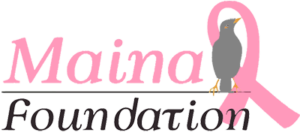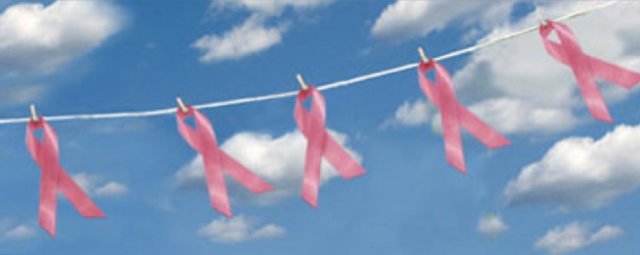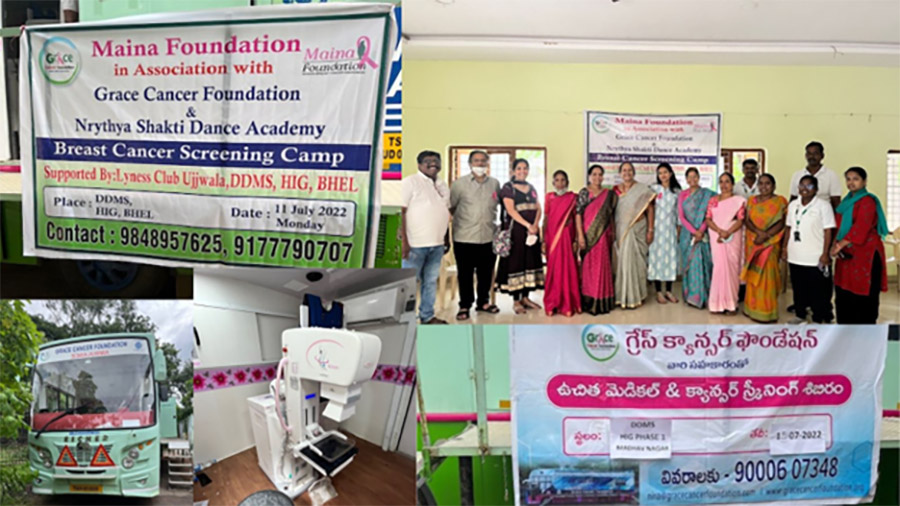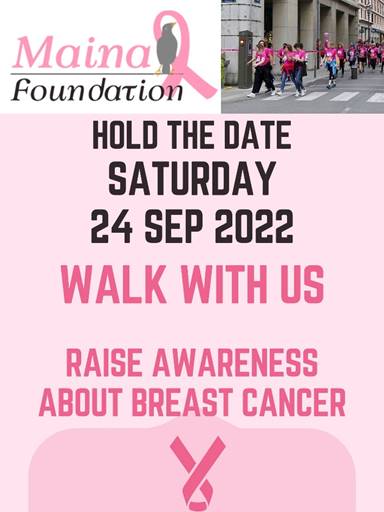
NEWSLETTER
August 2022
NO LIVES LOST TO BREAST CANCER

What is Cancer?
By Manju Soni
Welcome to the Maina Foundation Newsletter!
I have some exciting updates in this month’s newsletter.
First, I’ll do a basic overview of cancer. (Do I hear some of you groan that you hate science? Well, keep reading, it may not be that bad). I want to stress if you have any concerns whatsoever about your health, you should consult your healthcare provider, the Internet is NOT a doctor. However, it is a good place to gather information, and I’ve provided useful links in the newsletter. I found the Susan G. Komen website particularly helpful.
Secondly, we have an update about an inspiring college freshman who coordinated a breast cancer screening camp in Telangana State, India.
And lastly a date! Yes, a date and a venue, for our fun walk at the end of September.
Many years ago, when I was in clinical practice, I had an intern who asked the most basic questions, even though her peers rolled their eyes at her naivete. Personally, I enjoyed her questions, because they made me interrogate the assumptions I’d made about a patient, or a disease.
So, in this, and the next few newsletters I’m going back to basics to talk about:
· What is cancer, what is breast cancer
· Mammograms and warning signs of breast cancer
· What is BRCA
· Treatment options for breast cancer
· What can I (you) do to prevent breast cancer
What is cancer then?
We’ve all heard about it, and many of us have been touched by it, either directly or through loved ones, and its very name strikes fear in us. I know this because my own mom was diagnosed with breast cancer in 2011. More on this later.
Cancer is…
Cancer is a disease caused by uncontrolled cell growth. What is a cell I hear you ask. Cells are like the bricks that make up a house. There are trillions of cells in our body, they are the building blocks of organs like the heart, lungs, and brain, they are the transport system for nutrients in our blood, and they make up our framework as our skeleton, joints and ligaments.
Think of a cell as a sac filled with a gel, and inside this gel is a ‘brain’ called the nucleus.
The nucleus houses DNA which is the ‘boss’ of the whole show. The DNA controls how the cell performs its daily functions, when the cell should die (because cells age and stop working too), and DNA tells the cell when to divide, and when to stop dividing.
But sometimes, the DNA in a cell may become corrupted, very much like that annoying USB drive that is no longer recognized by your computer.
These corruptions of the cell’s DNA are called mutations.
There are many causes of DNA mutations—aging, genetics, smoking, alcohol, obesity, injury (e.g. to skin cells by sunlight or previous radiation) and other unknown factors.
And these mutations result in the DNA in the nucleus sending out incorrect signals, causing uncontrolled copying and growth of cells. These clumps of uncontrolled mutated cells all have the same mutated DNA and are called tumors.
It’s important to remember not every tumor is a cancer, many are benign, and may never require treatment. E.g., I have a small fat cell growth called a lipoma on my arm. It’s been there, for decades., and has not changed at all. (I think I should give it a nickname).
But benign tumors may still require treatment as they may occupy space, or damage surrounding tissue, such as tumors called meningiomas, which occur in the lining around the brain and occasionally apply pressure on the brain.
Tumors become cancerous when they begin to behave in a ‘nasty’ way:
· They divide without signals. Normal cells only divide when they receive such signals.
· They ignore signals that tell them to stop dividing, or signals that tell them to die.
· They invade into nearby areas and spread to other parts of the body, normal cells stop growing when they encounter other cells.
· They tell blood vessels to grow toward them. These blood vessels supply tumors with oxygen and nutrients and remove waste products from tumors.
· They hide from the immune system. The immune system normally eliminates damaged or abnormal cells.
It’s important to remember that as scary as this process of cancer development sounds, it’s not instantaneous. If the cancer is detected in its early stage, it can be treated, and the cancer may go into remission (need to be monitored for recurrence), and often cured.
What is breast cancer then?
The female breast is made up of 12–20 sections called lobes. Each lobe is made up of many smaller lobules, which produce milk in response to hormones in nursing women. Both the lobes and lobules are connected by milk ducts, which carry the milk to the nipple.
The cells of the lobules and the ducts are generally where cancer begins to form.
Some not-so-good facts:
· 1 out of 8 women will have a lifetime risk of developing breast cancer.
· Which makes it the second most common cancer amongst women, after skin cancer.
· The incidence of breast cancer varies by race and ethnicity, with Hispanic women having the lowest incidence, and White and Black women having the highest. However, there are other differences too, e.g. Black women are often diagnosed at a younger age, and have a higher death rate than other race and ethnic groups. A more detailed discussion can be found at the Susan G. Komen website
Some ‘hopeful’ facts:
· Women tend to be most scared of breast cancer, but in fact heart disease, especially heart attacks, cause more deaths than breast cancer, especially in postmenopausal women. Look after your hearts ladies.
· Breast cancer is also one of the cancers that are easier to detect, unlike for example pancreatic or brain cancers.
· If caught early the majority of breast cancers are curable.
· Many breast cancers are hormone (estrogen, progesterone), or HER2 (a protein) dependent, which gives doctors additional ways to fight the cancer.
We’ll continue our discussion about breast cancer in upcoming newsletters.
My mom’s story. At the age of 73, my mom felt a lump in her left breast. She used to have regular mammograms, but for some reason, (I blame myself for dropping the ball on this), she had not had one for three years.
After a number of tests, and a radioactive scan to see if there was any lymph node involvement, the doctor suggested a mastectomy. Of course, at this point we were devastated, with the possibility of chemotherapy with all its issues looming we were convinced she was close to death.
Her mastectomy showed an invasive ductal cancer, with no spread to the local lymph nodes. Her oncologist suggested we send the tissue for assessment for tumor markers. It was a costly test, $4500, and as she lives in South Africa, the tissue needed to be sent to the US. But it was worth it when the results indicated she did not require any chemotherapy. She was given a 5-year course of Tamoxifen, an estrogen receptor modulator. And now, she’s been 10 years cancer free.
My lesson from this experience is the diagnosis of cancer doesn’t have to be a death sentence, and like with my mom, it doesn’t have to have the scary prospect of chemotherapy and its attendant pain and complications.
But… early detection is key. Had we ensured Mom got routine mammograms, she may have required nothing more than a lumpectomy. This is where organizations like Maina Foundation are so critical.
Thank you for reading thus far, and please ensure you add annual mammograms to your own preventative tests, and to those of your loved ones.
1. HealthSketch: What is Cancer: https://www.youtube.com/watch?v=k_NHMjDYQOQ
2. NCI: what is cancer https://www.cancer.gov/about-cancer/understanding/what-is-cancer
3. CDC: what is breast cancer: https://www.cdc.gov/cancer/breast/basic_info/what-is-breast-cancer.htm
4. National Breast Cancer Foundation: https://www.nationalbreastcancer.org/breast-cancer-facts
5. Susan G. Komen: https://www.komen.org/breast-cancer/risk-factor/race-ethnicity/
Thank you!
Manju Soni (she/her) (pen name: M. J. Soni) is a former eye surgeon turned author. She is the author of Defying Apartheid, her debut nonfiction book that captures her experiences of being a young activist against apartheid. Her short fiction and essays has appeared in Ellery Queen Mystery Magazine, Akashic Books, Apeiron Review and The Establishment. She’s a member of Crime Writers of Color and Sisters in Crime (National and Connecticut).
NEWS
Ananya Mandava. a freshman on the Pre-Med track at Baylor University was inspired to give back by her dance teacher, Vandita Parikh from the Nruthya Shakti Dance Academy.
Ananya and others raised funds from Natyakalakaar (an Indian Fold dance competition), and with a contribution from Maina Foundation, they teamed up with the Grace Cancer Center to run a screening camp in BHEL, Telangana State, India.
The camp performed 74 mammograms, 49 pap smear tests and screened for diabetes and hypertension. 14 cases were referred to hospital for further investigation. In addition, the camp volunteers raised awareness of the importance of annual screening.
“I’ve known I wanted to pursue a career in the medical field and this camp has solidified my decision,” Ananya said. “I know that I would love to continue to help people and have the opportunity to change their lives for the better. For this opportunity I would like to thank my guru Vandita Aunty for teaching me the importance of giving back. I would like to thank Maina Foundation for helping me set up this camp, and to Alka Ji for being an amazing support. Lastly, I want to thank my parents for always supporting me.”
Maina Foundation founder, Alka Shrikhande said it the best, “It feels good to know the world is in good hands with young people like Ananya as our leaders.”

EVENTS

SAVE THE DATE – HOLIDAY BOUTIQUE SHOPPING
Shop for the holidays
October 1, 2022
Charlotte, NC
Stay tuned for more details
We thank you for your continued support!
For more information on Maina Foundation, and to help its mission, go to https://mainafoundation.org or contact us at 860-434-3985 or info@mainafoundation.org
SAVE A LIFE - DONATE NOW
Donations can also be mailed to:
8 Peppermint Ridge, Old Lyme, CT 06371, USA
